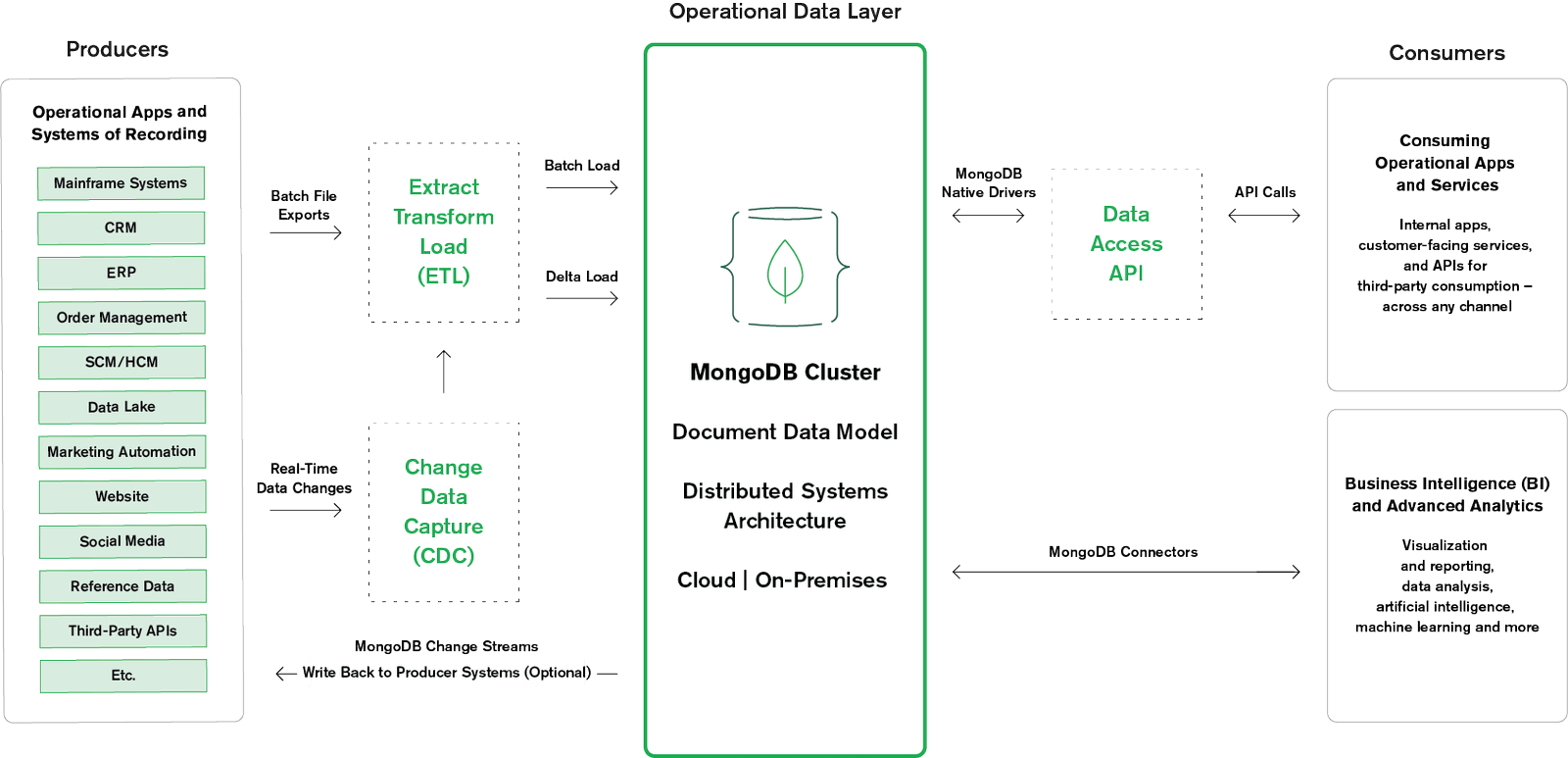Data as a Service
Your company’s data should be its greatest asset. It ought to be easy to develop new applications based on your data and to generate essential business insights—but for too many, legacy systems and databases make this difficult or impossible.
What is data as a service (DaaS)?
Data as a Service, DaaS, is considered one of the emerging cloud types. DaaS is hosted in the cloud and provides its data services as Software as a Service to the consumers. Consuming DaaS is a strategic investment for consolidating and organizing your enterprise data in one place, then making it available to serve new and existing digital initiatives.
MongoDB Atlas, the Data as a Service platform, is the only cross cloud, cross region platform built on top of MongoDB’s famous database software. Over 25k customers use this platform to innovate their application, leaving all the tedious work of managing the database to MongoDB.
Challenges of Legacy Systems vs DaaS
The keys to success in the digital age are how quickly you can build innovative applications, scale them, and gain insights from the data they generate—but legacy systems hold you back.

Lack of Agility

Data Locked in Silos

Poor Data Accessibility

Limited Data Support

Cloud Blockers

High Cost
Expensive hardware, huge jumps in costs as workloads scale, and punitive licensing impose barriers to innovation.
Solution: Get started with DaaS
The path to Data as a Service is to implement an Operational Data Layer (ODL). This data layer sits in front of legacy systems, enabling you to meet challenges that the existing architecture can’t handle—without the difficulty and risk of a full rip and replace. Depending on your requirements, an ODL can draw data from one or many source systems and power one or many consuming applications. An ODL can be used to serve only reads, accept writes that are then written back to source systems, or evolve into a system of record and eventually replace legacy systems entirely and simplify the enterprise architecture.

How to build a successful DaaS?
Data Layer Realization

This process for constructing an Operational Data Layer has been successfully implemented with many customers. Starting with clear definitions of project scope and identifying required producing and consuming systems is the first step to ensuring success. Based on these findings, we assign data stewards for clear chains of responsibility, then begin the process of developing and deploying the Operational Data Layer with loading and merging, data access API creation, validation, and optimization. This process is iterative, repeating in order to add new access patterns and consuming apps or enriching the ODL with new data sources.
A successfully implemented ODL is a springboard for agile implementation of new business requirements. MongoDB can help drive continued innovation through a structured program that facilitates prototyping and development of new features and applications.
Why use MongoDB Atlas as a data service?
When you choose MongoDB as the foundation for DaaS, you should definitely use MongoDB Atlas, the Data as a Service platform. This will allow you to boost your productivity and let MongoDB experts take care of all the heavy lifting for you.
MongoDB Atlas is the best way to work with data.

Ease

Speed
Unifying data in rich MongoDB documents means your developers write less code and your users get better performance when accessing data.

Flexibility

Versatility
Process data in any way your applications require, from simple queries to complex aggregations, analytics, faceted search, geospatial processing, and graph traversals.
Using multi-cloud and multi-region Atlas features, place the data where you need it.
MongoDB lets you intelligently put data where you need it.

Availability
Built-in redundancy and self-healing recovery ensure resilience of your modernized apps, without expensive and complex clustering add-ons.

Scalability

Workload Isolation
Run operational apps while also serving analytics, machine learning, and BI to unlock critical insights in real time—all on a single data platform.

Data Locality
MongoDB gives you the freedom to run anywhere.

Portability

Global Coverage
Deploy a MongoDB cluster across the globe—or turn to MongoDB Atlas, our Database as a Service, for coverage in 50+ regions of all the major cloud providers.

No Lock-In
Get the benefits of a multi-cloud strategy and avoid vendor lock-in—or if you want, run MongoDB yourself on-prem.
MongoDB enables data access and APIs.
Consuming systems require powerful and secure access methods to the data in the ODL. MongoDB’s drivers provide access to a MongoDB-based ODL from the language of your choice. Data as a Service reaches its fullest potential when you present a common Data API for applications; this layer can be custom built, using Atlas Data API, or MongoDB Realm can be used to expose access methods with a built-in rules engine for fine-grained security policies.
Data as a Service should also be available for analytics. The Connector for Business Intelligence allows analysts to connect to a MongoDB ODL with their BI and visualization tools of choice, or MongoDB Charts can connect directly to the ODL for native visualization. The Connector for Apache Spark exposes MongoDB data for use by all of Spark’s libraries, enabling advanced analytics such as machine learning processes. Finally, multiple data sources can be consumed via the Atlas Data Lake. Atlas data lets you directly query Atlas databases and AWS S3 together using a single API. Furthermore, data lakes can be linked to Charts or MongoDB Realm Services.
Data as a Service benefits
Reduce Risk
Achieve always-on availability to eliminate downtime (and any associated penalties)
Avoid exposing source systems directly to new consuming applications
Implement a system of innovation without the danger of a full “rip and replace” of legacy systems
Improve Innovation
Build new applications and digital experiences that weren’t possible before
Make full use of your data to build unique differentiators vs. the competition
Improve customer experience
Move Faster
Develop new applications 3-5x faster
Iterate quickly on existing services, adding new features that would have been impossible with legacy systems
Deliver insights that improve your competitiveness and efficiency
Lower Costs
Reduce capacity on source systems, cutting costs for licensing, MIPS, and expensive hardware
Leverage cloud and/or commodity infrastructure for workloads
In the long term, decommission legacy systems
Use cases of DaaS
Single View
DaaS is perfectly suited to generating a Single View of your business. When you unify your enterprise data and make it available as Data as a Service, the next step is to build an application to expose a single view of that data to those who need it. Better real-time visibility across the business, improved customer service, and insight for more intelligent cross-sell and up-sell opportunities are all within reach.
Mainframe Offload
Analytics
Providing Data as a Service doesn’t just support operational applications. It can also power the the analytics that make sense of your data – faster than a traditional data warehouse. Whether you’re analyzing your unified enterprise data set for business insights, running real-time analytics to take action based on algorithms, or reviewing usage patterns to inform application roadmaps, an Operational Data Layer can serve analytical needs with the appropriate workload isolation to ensure that there is no performance impact on production workloads.
And More
Building a mobile application to reach your customers any place, any time? Putting machine learning to work on your enterprise data? Building recommendation engines, adding social components to your UI, or personalizing content in real time? These applications, and any others you need to build, benefit from being able to access Data as a Service. What innovation could you power with all of your enterprise data easily and securely available in one place?
The future of Data as a Service
Companies understand that data and data services are the heart of the organization and key to its success. Together with the cloud-first adoption, Data as a Service has a bright future. Building and managing data systems in a legacy fashion adds a tremendous overhead to any organization’s IT efforts. Unlocking the innovation of your products with a platform like MongoDB Atlas, leaving behind all the heavy lifting of managing, upgrading and maintaining those stack components, allows companies to deliver faster and better.
Data as a Service will surely evolve in the next few years to open the potential of the digital worlds that surround us and will continue to improve the user experience and help you surpass your customers' wildest expectations.
Successful Data as a Service adoption
HSBC’s data assets are growing rapidly – from 56 PB in 2014 to 93 PB in 2017. Customers are demanding more, regulators are asking for more, and the business is generating more. In order to make trading data available to a multitude of new digital services, HSBC implemented an Operational Data Layer to become the single source of truth. The ODL, powered by MongoDB, enables HSBC’s development and architecture teams to meet the board’s strategy of using technology to make the bank “simpler, faster, and better”
Learn more
RBS implemented Data as a Service – which they call an Enterprise Data Fabric – in order to improve data quality, reduce duplication, and simplify architectures to become leaner. The results? Cost reduction, plans to decommission hundreds of legacy servers, an environment of collaboration and data sharing, and the ability to develop new applications in days, rather than weeks or months on the old systems “Data Fabric provides data storage, query and distribution as a service, enabling application developers to concentrate on business functionality.”
Learn more
HSBC’s data assets are growing rapidly – from 56 PB in 2014 to 93 PB in 2017. Customers are demanding more, regulators are asking for more, and the business is generating more. In order to make trading data available to a multitude of new digital services, HSBC implemented an Operational Data Layer to become the single source of truth. The ODL, powered by MongoDB, enables HSBC’s development and architecture teams to meet the board’s strategy of using technology to make the bank “simpler, faster, and better”
Learn more
RBS implemented Data as a Service – which they call an Enterprise Data Fabric – in order to improve data quality, reduce duplication, and simplify architectures to become leaner. The results? Cost reduction, plans to decommission hundreds of legacy servers, an environment of collaboration and data sharing, and the ability to develop new applications in days, rather than weeks or months on the old systems “Data Fabric provides data storage, query and distribution as a service, enabling application developers to concentrate on business functionality.”
Learn more

Alight Solutions (formerly part of Aon PLC) provides outsourced benefits administration for close to 40 million employees from over 1,400 organizations, but retrieving customer data from multiple frontend and backend source systems meant high mainframe MIPS costs, scaling difficulties, and high query latency. Moving to Data as a Service delivered from an ODL on MongoDB reduced query latency by 250x for better customer experience, lowered peak mainframe consumption to reduce costs, and unlocked new business innovation.
Learn more
Barclays is solving one of the hardest challenges facing any enterprise: a true 360 degree view of the customer with an ODL that gives all support staff a complete single view of every interaction a customer has had with the bank. This is helping Barclays drive customer interactions to new digital channels and improve the customer experience.
Learn more
MongoDB Atlas allows us to deal with multiple cloud providers while avoiding complexity. With Atlas, it’s just BOOM, and make the move. No need to scramble.
Read More
Featured Resources